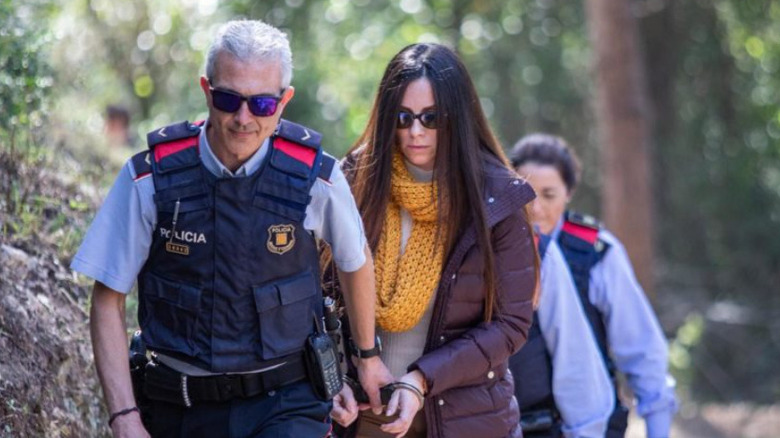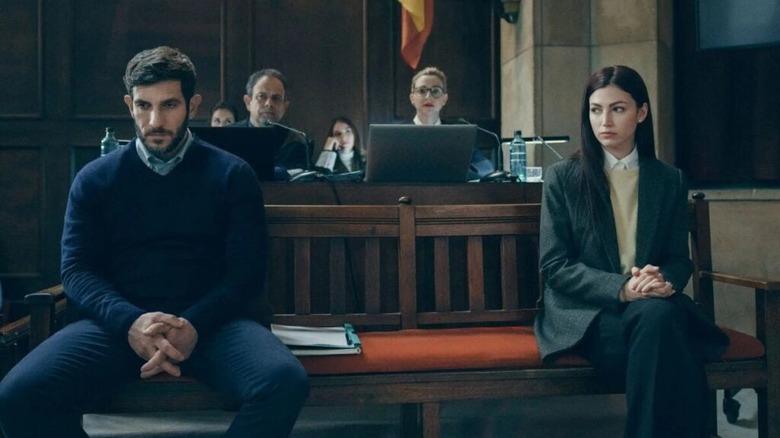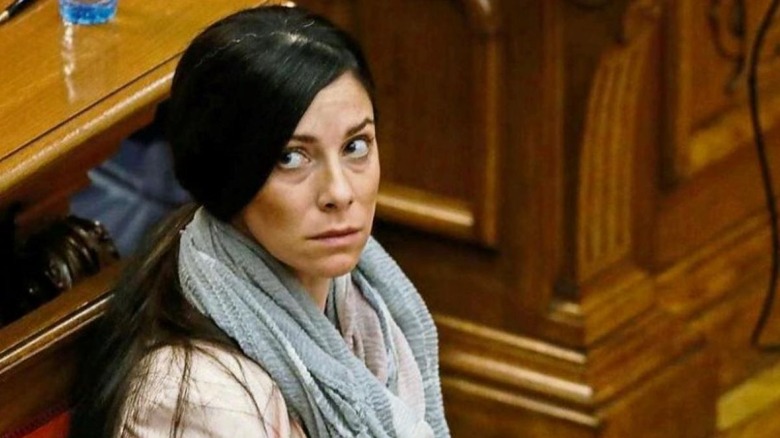The Murderous True Story Of Rosa Peral And Netflix's Burning Body
The real story surrounding Netflix's latest true crime offering is tailor-made for tabloid fodder. Directed by Jorge Torregrossa and starring Úrsula Corberó ("Money Heist"), "Burning Body" serves as yet another cautionary tale about the tangled web we weave when secret love affairs, ghastly intrigue, and unthinkable acts of violence collide.
Based on one of Spain's most chilling murder cases referred to by the local press as "el Crimen de la Guardia Urbana" (the crime of the Urban Guard), the brutal killing of a police officer caused a media frenzy. On May 4, 2017, the remains of Officer Pedro Rodriguez were found among the ash of a torched automobile that had been completely engulfed in flames. It looked like someone had gone to great lengths to ensure that there was no physical evidence, a clear sign that the person or persons in question knew what they were doing. The only identifying signs linking Rodriguez' name were the motor's chassis number and a prosthetic device that was discovered at the scene. It also seemed a little suspicious that the ashes of his body were found in the trunk of his own car.
A trial followed involving two of Rodriguez' fellow officers, Rosa Peral and Albert Lopez, who were both in a relationship at the time of his murder. The focus fell onto Peral after it was discovered that she was also romantically linked to Rodriguez, sparking suspicion and a potential motive.
In what's proved to be a winning formula, Netflix has released the documentary "Rosa Peral's Tapes" ("Las Cintas de Rosa Peral") in conjunction with "Burning Body" as the sensationalized, admittedly sexier version of the tragic, real-life events surrounding the crime.
Should you watch the film or the documentary first?
With increasing frequency, audiences have been presented with two options when it comes to choosing how they want to digest the latest true crime shocker. At the risk of being controversial, Netflix has still enjoyed great success with the one-two punch of "Monster: The Jeffrey Dahmer Story" starring Evan Peters and the stark interviews contained within "Conversations with a Killer: The Jeffrey Dahmer Tapes." In many cases, it's easy to wind up watching the docu-series and the television series to ensure that you're informed and entertained in one fell swoop.
In the case of Rosa Peral, it's probably best to watch "Burning Body" before diving into the in-depth testimony found in the documentary "Rosa Peral's Tapes." The film version plays up a classic example of "he said, she said," with Rosa and Albert both offering up completely different testimonies about the murder of Pedro Rodriguez.
Assuredly, one of the reasons so many people have been tuning into "Burning Body" is the way it unfolds like a mystery-filled telenovela that's just as sexy as it is disturbing. Across its eight-episode arc, "Burning Body" does look to delve into the more procedural aspects of the case while still managing to offer up some of the more human elements that led up to the murder.
What really happened that night?
With the dual nature of how the story is presented in "Burning Body," audiences may find it a bit confusing when trying to decipher all the clues that are presented. Who is telling the truth and who is lying to protect themselves? While that may prove frustrating, it's done intentionally.
In Rosa Peral's defense, she purported that Albert became increasingly angered and jealous regarding the relationship between Rosa and Pedro. Her statement claimed that Albert murdered Pedro in an uncontrolled fit of rage, and then forced her to get rid of the body. With both lovers also being seasoned police officers, it's reasonable to believe that each of them had the knowledge necessary to dispose of a corpse without leaving any evidence.
Naturally, the plot thickens. Complicating matters, Peral was also a mother of two children. She claimed that she had to hide Albert's crime to ensure that no harm would come to her kids after he had threatened to kill them if she didn't go along with the cover-up.
Not surprisingly, Albert Lopez had a slightly different recollection of the events from that fateful night. He claimed that Rosa was fearful of Pedro's wrath if he ever found out about their affair. Scared for her life, it was Peral who murdered Pedro, with Albert arriving some time later to help dispose of the body to protect her.
Thanks to cell phone triangulation and reconstructing the entire crime scene, the police placed both of them together at the time of Pedro's murder. Using Pedro's cell phone after his death, Rosa had also attempted to convince family and friends that he was still alive and well.
Case closed.
The documentary paints a more complex picture of Peral
The series "Burning Body" and the documentary both come to the same conclusion, ultimately, but "Rosa Peral's Tapes" paints a much more sympathetic portrait of the former policewoman. In an attempt to humanize Peral, it was crucial for filmmakers Carles Vidal Novellas and Manuel Pérez Cázeres to delve into her backstory and her sordid, complicated love life before she ever even laid eyes on Pedro Rodriguez and Albert Lopez.
In her first interview from behind bars, Peral speaks about multiple past relationships including a man named Ruben who became the father of her two daughters. During that time, she was also involved with Oscar, a fellow police officer who betrayed her privacy by sharing private photographs of Rosa without her consent. The images circulated around the department, making her professional life unbearable.
During the trial, the prosecution zeroed in on Peral's past discretions in an attempt to discredit her story and her character. Peral may have been playing the victim to gain sympathy in the documentary, but she also may have been unfairly maligned over the course of a very lengthy trial. She is currently serving a 25-year sentence. Albert Lopez, in contrast, was sentenced to twenty years behind bars.
"Burning Body" and "Rosa Peral's Tapes" are now streaming on Netflix.



